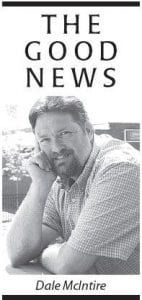Labor Day seemed as good a day as any to begin the landscaping around the new church building. We’ve been talking about it, planning for it, envisioning what it would all look like. Finally we had a day when we could concentrate on working the plan and digging the holes.
First we gathered tools. Then we gathered the shrubs and got them onto the truck, moved, and unloaded at the church. Then we went back and loaded mulch, which we also unloaded at the church. Then we went and picked up, by hand, several hundred pounds of rock for the border. I decided not to unload that until we were ready to use it. Then it was time to take the machine and dig the holes.
The first hole was not so bad. We planted a Russian Olive in memory of Linnie Quarles. The second hole posed no problem. We planted another Russian Olive. The third hole went smoothly as well. In went a Pagoda Dogwood. (That’s going to be a beautiful tree.) Thencame “the fourth hole.”
The tines of the scoop bit into the packed dirt of the gravel parking lot. We had already anchored the backhoe by dropping the bucket and the stabilizer legs. The scoop began its short journey from starting position to full. It moved four inches out of the expected twenty-four and stopped. The hydraulically powered mini-mammoth stopped in mid-scoop. We were digging in Cook County. We found a rock.
What a rock it must have been. The teeth on the end of the bucket hooked on and brought the entire backhoe six inches closer to the hole. The rock didn’t budge. Tried again. Once again the backhoe, heavier and anchored, moved but the rock didn’t. I envisioned a boulder the size of Massachusetts, or thought that perhaps we’d tied into bedrock and were pulling against the entire North American continent.
We took a different approach and after some artsy maneuvering managed to get the scoop under the rock and lift it free. It was about fourteen inches long, four inches tall, and six inches wide. (Think four Subway sandwiches stacked two abreast and two high.) It probably weighed ten pounds. The backhoe is twenty feet long, eight feet tall, and weighs a ton. But the rock moved the backhoe before the backhoe could move the rock.
A well entrenched sin, a long-standing destructive habit, a deeply rooted lie; these things aren’t removed easily from the heart. Like a small stone in a densely packed parking lot, they take extreme force to remove. What force moves these “rocks” lodged in the heart? God’s loving grace applied through the death of his Son, Jesus.
Take the lie that many of us buy into: “You’re no good. There’s no way God could love you.” It worms its way deep into the heart, affecting spiritual, emotional, psychological, and even intellectual development. We learn to live in the context of this lie. We build our lives, in one way or another, as an attempt to negate its effect. Words don’t dislodge it. Selfeffort doesn’t remove it, but instead draw us only closer to the abyss of despair. We need more.
So God sent Jesus to die on the cross to show us undeniably that he loves us, to dislodge the lie from our hearts. God’s love, demonstrated, proven, in the death of his Son, gets under the lie and provides the spiritual force necessary to remove the lie. His love is the force. Your faith is the machine that applies the force.
That’s the Good News.
Pastor Dale McIntire has served as pastor of the Cornerstone Community Church in Grand Marais since April of 1995.



Loading Comments